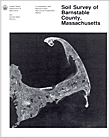The following is a map unit description from the "Soil Survey of Barnstable County, Massachusetts (Fletcher, 1993)"

PmC-Plymouth loamy coarse sand, 8 to 15 percent slopes. This very deep, strongly sloping, excessively drained soil is on small hills and ridges in areas of glacial lake and ice-contact deposits and on ground moraines. It makes up about 0.7 percent (1,839 acres) of the survey area. It is mapped mainly in the Plymouth-Carver-Barnstable general soil map unit. Areas are irregular in shape and range from 5 to 150 acres in size.
Typically, the surface is covered with an organic layer. This layer is about 1 inch of loose, undecomposed pine needles, leaves, and twigs and 1 inch of partly decomposed and well decomposed organic material. The surface layer is about 3 inches thick. It is black, very friable loamy coarse sand in the upper 1 inch and gray, loose coarse sand in the lower 2 inches. The subsoil is about 26 inches thick. In sequence downward, it is 1 inch of dark brown, very friable gravelly loamy coarse sand; 5 inches of strong brown, very friable gravelly loamy coarse sand; 1 0 inches of yellowish brown, very friable gravelly loamy coarse sand; and 1 0 inches of light yellowish brown, loose gravelly coarse sand. The substratum extends to a depth of 65 inches or more. It is light brownish gray, loose gravelly coarse sand in the upper 12 inches and pale brown, loose coarse sand in the lower part.
Included with this soil in mapping are small areas of Barnstable, Carver, Hinckley, and Nantucket soils. Also included are areas where slopes are less than 8 percent or more than 15 percent and a few areas where stones are on the surface. Included soils make up about 35 percent of this unit.
Permeability is rapid in the subsoil of the Nantucket soil and very rapid in the substratum. Available water capacity is low. Depth to the seasonal high water table is more than 6 feet.
Most areas are used as woodland. Some areas have been developed for homesites, and a few areas are farmed.
This soil is poorly suited to cultivated crops. The low available water capacity and the susceptibility to erosion are management concerns. Irrigation is needed for most cultivated crops. Mixing plant residue and manure into the surface layer increases the available water capacity. Farming on the contour or across the slope, terracing, stripcropping, including grasses and legumes in the crop rotation, growing cover crops, and applying a system of conservation tillage help to control runoff and erosion.
This soil is poorly suited to hay and pasture. The main management objective is the prevention of overgrazing, which reduces the hardiness and density of desirable plants. Proper stocking rates, timely grazing, and restricted use during wet periods help to maintain plant density and minimize surface compaction.
The slope is the main limitation if this soil is used as a site for buildings. Land shaping is generally needed. Buildings and lots should be designed so that they conform to the natural slope of the land. Erosion is a hazard during and after construction. Planting well suited grasses as soon as possible after the surface is disturbed minimizes the erosion hazard.
This soil is poorly suited to septic tank absorption fields because of the slope and the rapid and very rapid permeability. The soil does not adequately filter the effluent. The poor filtering capacity may result in the pollution of ground water. The hazard of pollution increases with the density of housing. Installing the distribution lines on the contour or in areas that were graded during construction of the dwelling helps to overcome the slope. Precautionary measures may be necessary in some areas.